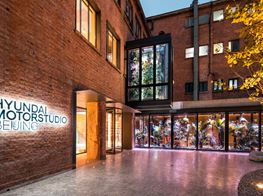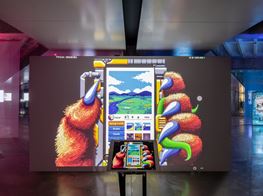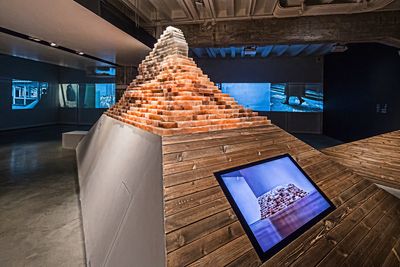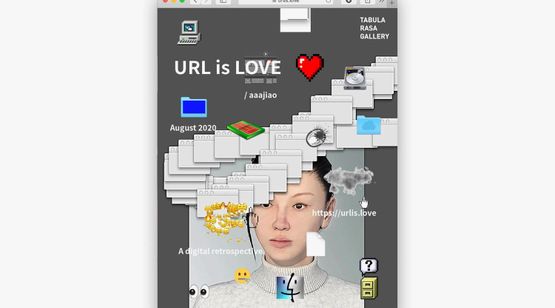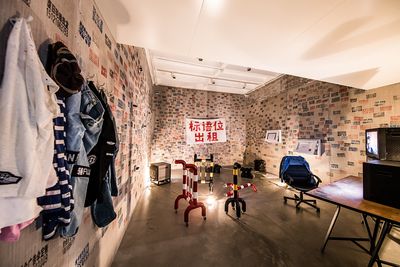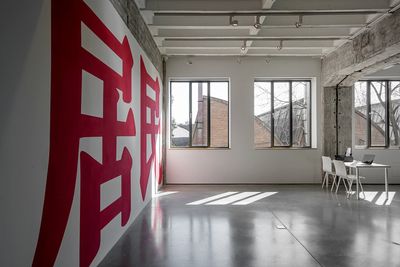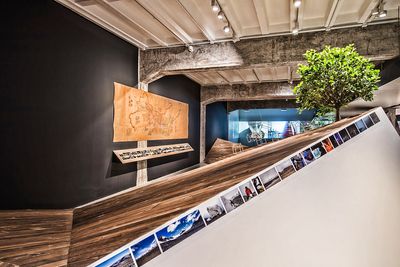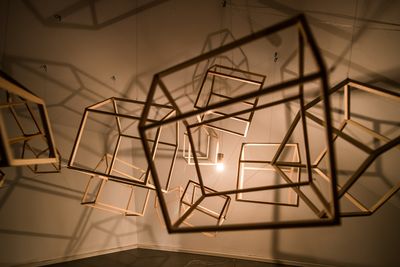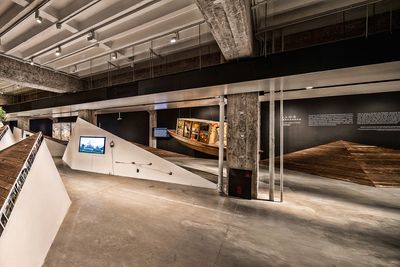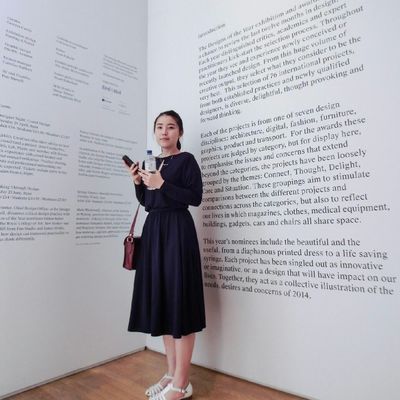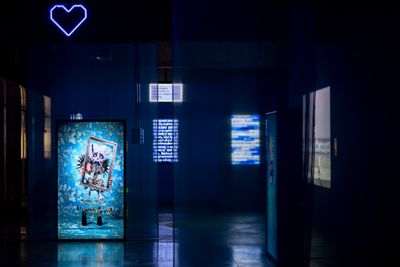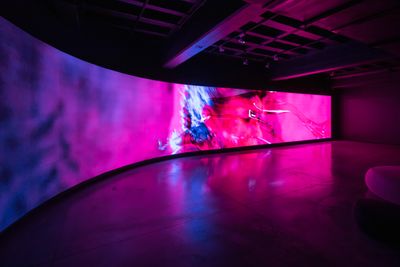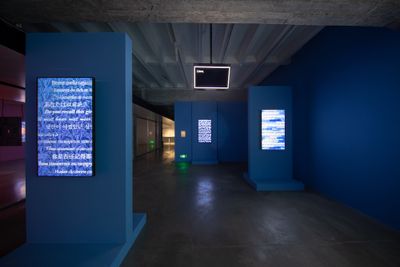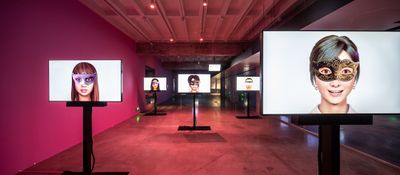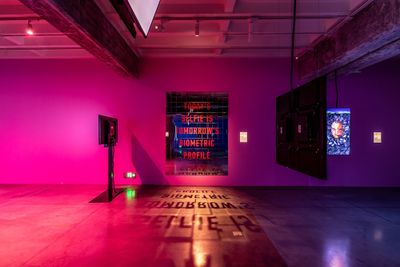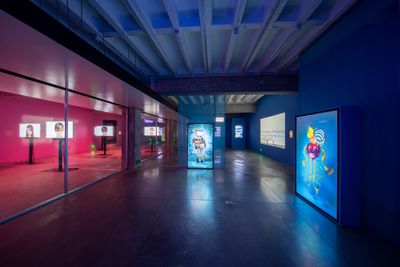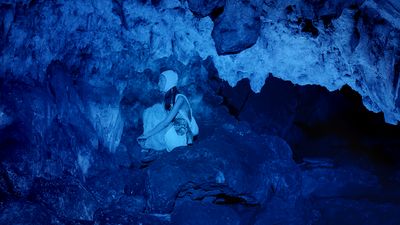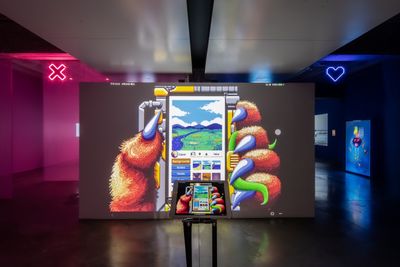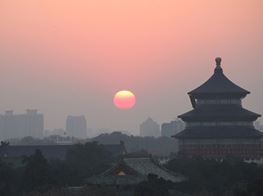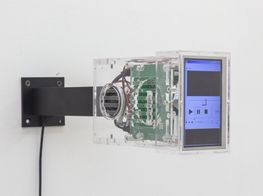Love and Artificial Intelligence
Hyundai Motorstudio Beijing | Sponsored Content
Exhibition view: AI: Love and Artificial Intelligence, Hyundai Motorstudio Beijing (30 September 2020–3 January 2021).
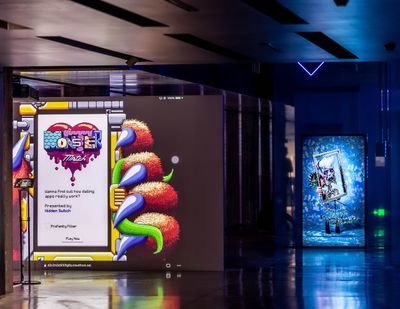
Exhibition view: AI: Love and Artificial Intelligence, Hyundai Motorstudio Beijing (30 September 2020–3 January 2021).
Located in Beijing's 798 Art District, Hyundai Motorstudio Beijing opened in 2017 as a gathering place for Chinese contemporary art. As a fertile experimental ground for interdisciplinary practices, Hyundai Motorstudio Beijing brings together a wide array of artistic explorations across disciplines with the mission to promote sustainable development. It was the fifth Motorstudio to open worldwide after three locations in Korea—Seoul, Goyang, Hanam—and one in Moscow, Russia.
One of the key projects of Hyundai Motorstudio Beijing is the Hyundai Blue Prize, an annual award given to emerging curators with insightful approaches to presenting the complexities of contemporary Chinese society.
In the past three years, the Hyundai Blue Prize has become the platform for young Chinese curators to realise innovative concepts, which bring together art and technology. Each year, they submit exhibition proposals based on themes that reflect Hyundai Motor Company's long-term vision.
Through past iterations of the Hyundai Blue Prize, award winners have realised their thoughtful curatorial visions in the form of thematic exhibitions at the Hyundai Motorstudio Beijing, such as The Precariousness by Li Jia (23 March–20 May 2018), Boat Traveling on Land by Li Jie (8 June–8 October 2018), Quasi-Nature: Bio Art, Borderline and Laboratory by Jo Wei (22 March–16 June 2019), Lying Sophia and Mocking Alexa by Iris Long (12 July–21 October 2019), and Play Societies: Wolves, lynx, and ants by Chen Min and Zhang Yehong (16 June–9 September 2020), which opened earlier this year.
Continuing this legacy, Hyundai Motorstudio Beijing is pleased to present the winning exhibition of Hyundai Blue Prize 2020, AI: Love and Artificial Intelligence, curated by Jenny Chen Jiaying. The exhibition reflects on the lessons that millennials have learned about love in the era of the internet, through 13 works by 12 artists, including Jonas Lund, aaajiao, Chen Zhou, Johanna Bruckner, and Stine Deja.
On the eve of the opening, Cornelia Schneider, head of global experiential marketing at Hyundai Motor Company, and curator Jenny Chen Jiaying spoke to Ocula Magazine about love, artificial intelligence, and art.
PLAside from running the Hyundai Blue Prize, Hyundai Motor Company also sponsors international art museums such as Yuz Museum in Shanghai and Tate, in the U.K. What inspired Hyundai Motor Company to become involved in art through sponsorship?
CSHyundai Motor Company envisions progress for humanity and looks beyond products to actualise its vision through art and cultural initiatives. The purpose of Hyundai Motor Company's art and cultural initiatives is to build pillars for a sustainable and progressive future by exploring relevant conversations and creating unique experiences for our customers.
We believe that art enhances an understanding of humanity, design responds to people's needs, and innovation reinvents our everyday lives. To support art and culture and to offer more meaningful experiences to our customers and employees, we have built strong connections and presented various art projects with our global partners, such as Tate (U.K.), Los Angeles County Museum of Art (U.S.A.), National Museum of Modern and Contemporary Art (Korea), and Yuz Museum (China).
PLEvery year, Hyundai Motorstudio Beijing selects themes such as 'Social Mobility' (2017), 'Future Humanity' (2018), 'Social Intelligence' (2019), and 'Resilient/Resonant City Resonance' (2020) to reflect on cutting-edge issues in the age of technological evolution. How are these curatorial themes decided upon? What is the connection between such universal issues and cities like Beijing?
CSThe annual theme selected by the Hyundai Blue Prize is based on the brand philosophy of Hyundai Motor Company, 'Progress for Humanity'. At the same time, it reflects thought-provoking issues in our society.
In the 21st century, individuals, collectives, cities, and countries are highly interconnected online and offline. Now, it has become very easy for a city's social issues to become universal issues.
We believe that as a megacity, Beijing is not only the capital of China, but is also a gathering place for different cultures, countries, and social development. It provides the perfect environment for us to examine the current situation of society and for the public to discover and reflect on its problems more actively.
PLWhat is the difference between Hyundai Motorstudio Beijing and Hyundai Motorstudios in other cities?
CSHyundai Motorstudio Beijing is the only Hyundai Motorstudio space dedicated to art and technology. We focus on discussing social issues through the expression of art by engaging audiences to ask thought-provoking questions to work towards a better future.
PLWhat challenges has Motorstudio faced as a result of the Covid-19 pandemic?
CSWith the Hyundai Blue Prize entering its fourth year this year, the biggest challenge was to maintain smooth operation of the programme amid an unforeseen disaster.
Although the original schedule was delayed, we took this time as an opportunity to review our work processes of the past three years and discuss future developments. We have launched virtual experiences of the winners' exhibitions in 2020.
We have also strengthened the mentorship programme by involving more professionals based in China while continuing conversations with international curators through online conferences and meetings.
It can be said that the pandemic has not only affected our work and lifestyle—it has also created new methods of communication.
PLWhen setting up the Hyundai Blue Prize for young Chinese curators, did Hyundai Motorstudio draw lessons from other international art awards?
CSThere are not many curatorial awards, especially for young curators, within China or even internationally. This means that there was no exact model we referenced when we created this new award.
The original intention was to encourage the development of young Chinese curators by giving them a chance to showcase their ideas on a proper platform and to connect them with the international art scene. Based on Hyundai Motor Company's understanding of the curatorial industry and the needs of young curators in combination with our own artistic resources, we were able to plan this unique award.
Also, thanks to Hyundai Motorstudio Beijing's space and location, the award successfully combines the public, media, art practitioners, and industry experts to gather and form an active platform.
PLWhy is this award set up specifically through Hyundai Motorstudio Beijing?
CSThe Hyundai Blue Prize is an art award for young Chinese curators. It is dedicated to cultivating and assisting young curators who are currently working in China and do not receive sufficient support.
The prize is based on our firm belief that curatorial skills are necessary to overcome the issues we face today. Those skills include teamwork, interdisciplinary thinking, the wisdom to explore a wide range of issues, as well as a visionary eye for presenting creative ideas to diverse audiences. As a platform for the exchange of art, culture, sustainable, and creative ideas in China, Hyundai Motorstudio Beijing shares the same mission and vision as the Hyundai Blue Prize.
PLWhat are Hyundai Motor Company's expectations for the award?
CSThe Hyundai Blue Prize aims to inspire and promote innovative development and create a better future for the next generations. The exhibitions curated by the Hyundai Blue Prize winners connect people through cultural experiences that can enrich their lives and open up conversations for a better future.
The colour blue symbolises youth, the future, and technological innovation, as represented by this award. We hope that this award will help young Chinese curators to advance to the international stage and, at the same time, familiarise people with exhibition curating and art in general.
PLJenny, you have chosen a playful pun in your exhibition title that reflects both love and artificial intelligence. Where did this pun come from?
CJYMy thinking about the connection between algorithm and affection came from personal experience. Of course, what was equally important to my idea was the curatorial theme of 'Social Intelligence', which I broke down into two categories: 'social relationship' and 'artificial intelligence'.
But what kinds of social relationships? When it comes to love, I am heavily influenced by In Praise of Love (2009) by Alain Badiou and On Love (2013) by Luc Ferry. My initial exhibition proposal was named after the title of Badiou's book, hoping to reveal the precariousness that lies beneath the praises of love.
The meaning of love is hollowed out as its definition is trivialised. I think of the exhibition as the phenomenology of A.I. and love.
I came across this pun while listening to music. I saw the word on the music streaming app, NetEase Cloud Music, on an animated spinning record. On it, a Chinese character and its corresponding pinyin were written, 爱 ài, which means love. It occurred to me that the pinyin was also an abbreviation for 'artificial intelligence'.
However, this deceptively unique pun has become ubiquitous thanks to the internet. Later, I found out that this pun appears in Wang Leehom (王力宏)'s album A.I. 愛 in 2017. Regardless, I decided to keep it, because it aligns so well with what I intended to say.
PLThe etymology of the word 'love' encompasses agape, devotional love; eros, romantic, passionate love; and philia, affectionate and maternal love. Why do you focus only on eros and philia in the exhibition?
CJYThe Ancient Greeks had three words for love: eros, philia, and agape. I chose to focus on eros and philia. The material love you mentioned is in fact fetishism—a modern neurosis rooted in consumer capitalism and is only explored in depth much later.
In the exhibition, I wanted to articulate the relationship between people, so I decided to omit material love; nevertheless, some works allude to it. Agape is the most difficult to grapple with; it's often associated with religious sentiment, a subject that is well beyond the scope of this exhibition. This is why I didn't mention agape in the text.
PLWhy do you choose this particular time to rethink our circumstances with technology and emotions?
CJYAt the time of writing the proposal, I was in a long-distance relationship. Many people my age are somewhat familiar with such a situation. I also realised that more and more friends of mine are dependent on dating apps to find love and to sustain relationships.
Intimate relationships have become digitised. The medium of intimate relationships is both our bodies and optical fibers, otherwise, it would be difficult to sustain a relationship in the era of global migration—Covid further testifies to that. Love today is cyborg-esque.
These close personal sentiments echo what I read in the literature about love. Badiou points out that love is a 'truth procedure', and Luc Ferry insists that love could provoke a revolution. For me, what I can do is make people revisit and reimagine this seemingly cliché subject.
PLIs the exhibition designed as a dichotomous structure to reflect on the law of duality, or perhaps the phenomenon of the political left and right? What is the basis for this division?
CJYThe reason behind the dichotomous structure, on the one hand, is spatial reality. Hyundai Motorstudio Bejing's space is a narrow rectangle split by several consecutive columns. In the proposal, I tried to consolidate the columns by adding a wall. The design later turned into the blueprint of the current layout.
On the other hand, the dichotomous structure echoes the game Monster Match, which simulates the interface of certain virtual dating apps. The audience can swipe left or right as per their preference. 'Swipe right to like, swipe left to dislike' becomes a potent reference, as well as a metaphor for our manipulated emotions.
Thirdly, the design reflects the result of collaborative filtering, which is an algorithm standard in many apps. It indeed links to the political polarisation of the extreme right and left.
I categorised the works based on a generic tone of likes and dislikes—a very subjective criterion without any objective basis. To some degree, it testifies to my bias, just like algorithms.
PLMost of the works need to be presented through monitors or screens, resulting in a lack of warmth in the exhibit. Was that intentional?
CJYNot at all. We set out to create a tender exhibition. The layout, which was finished by the spatial designer and I, reflects a tension.
On the one hand, it alludes to what you described as lacking warmth, as a result of the screens and monitors, which to some degree mirrors our reality. On the other hand, we employed some soft materials, as well as some bold colours.
In addition, the nexus of this exhibition is the Postcard Project, a collaborative effort between graphic designer He Rongkai and I. I consider it as a 'romantic retreat' through the power of handwriting. It is a public programme we've been working on since the quarantine.
The purpose is to retreat from the digital network to a primitive one bound by objects; specifically, a transmission system made possible by the postal service. I hope that the audience can spread the love by sending postcards to friends—especially those stuck in strange places for various reasons—not just 'likes' on social networking platforms.
PLIn conceiving the exhibition, were you drawn to specific artists or artworks?
CJYBlue Hole (2017) by Chen Zhou was one artwork that I was drawn to. The artist's rhetoric of comparing a blue screen to a blue hole is very attractive to me and fits the original intention of this exhibition.
PLWhen communicating with the artists in the show, what topics did you discuss the most?
CJYProbably love and sincerity. In fact, the artists featured in this exhibition have already given plenty of thoughts on the subject of love and technology, which I put together.
Because of Covid, we cared for each other's wellbeing even more so during in-person meetings and work correspondences.
PLFor the show, you reference many related books, including Luc Ferry's On Love and Rabindranath Tagore's Gitanjali (1910). Tagore focuses on humanistic love, while Ferry composes an ode in honour of his god. When we talk about the fundamentals of love, do you think we inevitably circle back to the realm of religion?
CJYSince Nietzsche declared that God is dead, I think it has become important to be careful when thinking about the religious dimension of love. Agape may have developed from religious devotion, but it could also be described as dogmatic love.
Personally, I think agape is being devoted to a nameless god, which is what I learned from Tagore. Today, however, I am more willing to cast light on Luc Ferry's interpretation of love—the kind of love brought together by empathy, or 'the revolution of love'. I hope there will be more what Badiou terms as 'the subject of love'.—[O]

